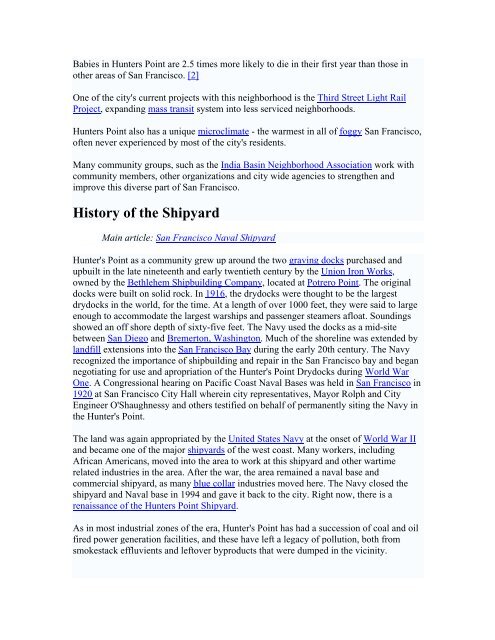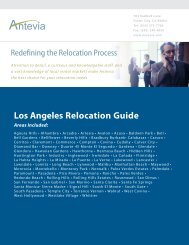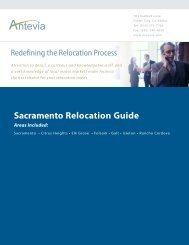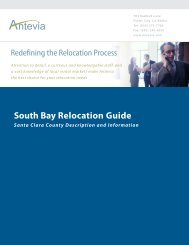San Francisco Relocation Guide - Antevia
San Francisco Relocation Guide - Antevia
San Francisco Relocation Guide - Antevia
Create successful ePaper yourself
Turn your PDF publications into a flip-book with our unique Google optimized e-Paper software.
Babies in Hunters Point are 2.5 times more likely to die in their first year than those in<br />
other areas of <strong>San</strong> <strong>Francisco</strong>. [2]<br />
One of the city's current projects with this neighborhood is the Third Street Light Rail<br />
Project, expanding mass transit system into less serviced neighborhoods.<br />
Hunters Point also has a unique microclimate - the warmest in all of foggy <strong>San</strong> <strong>Francisco</strong>,<br />
often never experienced by most of the city's residents.<br />
Many community groups, such as the India Basin Neighborhood Association work with<br />
community members, other organizations and city wide agencies to strengthen and<br />
improve this diverse part of <strong>San</strong> <strong>Francisco</strong>.<br />
History of the Shipyard<br />
Main article: <strong>San</strong> <strong>Francisco</strong> Naval Shipyard<br />
Hunter's Point as a community grew up around the two graving docks purchased and<br />
upbuilt in the late nineteenth and early twentieth century by the Union Iron Works,<br />
owned by the Bethlehem Shipbuilding Company, located at Potrero Point. The original<br />
docks were built on solid rock. In 1916, the drydocks were thought to be the largest<br />
drydocks in the world, for the time. At a length of over 1000 feet, they were said to large<br />
enough to accommodate the largest warships and passenger steamers afloat. Soundings<br />
showed an off shore depth of sixty-five feet. The Navy used the docks as a mid-site<br />
between <strong>San</strong> Diego and Bremerton, Washington. Much of the shoreline was extended by<br />
landfill extensions into the <strong>San</strong> <strong>Francisco</strong> Bay during the early 20th century. The Navy<br />
recognized the importance of shipbuilding and repair in the <strong>San</strong> <strong>Francisco</strong> bay and began<br />
negotiating for use and apropriation of the Hunter's Point Drydocks during World War<br />
One. A Congressional hearing on Pacific Coast Naval Bases was held in <strong>San</strong> <strong>Francisco</strong> in<br />
1920 at <strong>San</strong> <strong>Francisco</strong> City Hall wherein city representatives, Mayor Rolph and City<br />
Engineer O'Shaughnessy and others testified on behalf of permanently siting the Navy in<br />
the Hunter's Point.<br />
The land was again appropriated by the United States Navy at the onset of World War II<br />
and became one of the major shipyards of the west coast. Many workers, including<br />
African Americans, moved into the area to work at this shipyard and other wartime<br />
related industries in the area. After the war, the area remained a naval base and<br />
commercial shipyard, as many blue collar industries moved here. The Navy closed the<br />
shipyard and Naval base in 1994 and gave it back to the city. Right now, there is a<br />
renaissance of the Hunters Point Shipyard.<br />
As in most industrial zones of the era, Hunter's Point has had a succession of coal and oil<br />
fired power generation facilities, and these have left a legacy of pollution, both from<br />
smokestack effluvients and leftover byproducts that were dumped in the vicinity.







